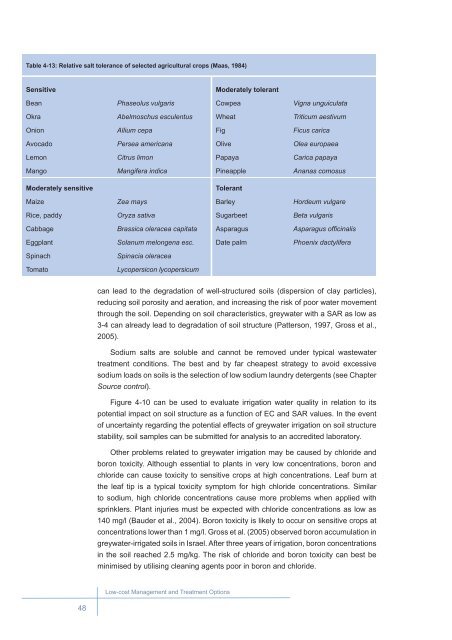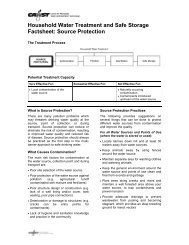Greywater Management in Low and Middle-Income Countries - SSWM
Greywater Management in Low and Middle-Income Countries - SSWM
Greywater Management in Low and Middle-Income Countries - SSWM
You also want an ePaper? Increase the reach of your titles
YUMPU automatically turns print PDFs into web optimized ePapers that Google loves.
Moderately tolerant<br />
Bean Cowpea Vigna unguiculata<br />
Okra Abelmoschus esculentus Wheat <br />
Onion Allium cepa Fig Ficus carica<br />
Avocado Persea americana Olive Olea europaea<br />
Lemon Citrus limon Papaya Carica papaya<br />
Mango P<strong>in</strong>eapple Ananas comosus<br />
Moderately sensitive<br />
<br />
Maize Zea mays Barley <br />
Rice, paddy Sugarbeet <br />
Cabbage Brassica oleracea capitata Asparagus <br />
Eggplant Date palm <br />
Sp<strong>in</strong>ach<br />
Tomato<br />
Sp<strong>in</strong>acia oleracea<br />
Lycopersicon lycopersicum<br />
can lead to the degradation of well-structured soils (dispersion of clay particles),<br />
reduc<strong>in</strong>g soil porosity <strong>and</strong> aeration, <strong>and</strong> <strong>in</strong>creas<strong>in</strong>g the risk of poor water movement<br />
through the soil. Depend<strong>in</strong>g on soil characteristics, greywater with a SAR as low as<br />
3-4 can already lead to degradation of soil structure (Patterson, 1997, Gross et al.,<br />
2005).<br />
Sodium salts are soluble <strong>and</strong> cannot be removed under typical wastewater<br />
treatment conditions. The best <strong>and</strong> by far cheapest strategy to avoid excessive<br />
sodium loads on soils is the selection of low sodium laundry detergents (see Chapter<br />
Source control).<br />
Figure 4-10 can be used to evaluate irrigation water quality <strong>in</strong> relation to its<br />
potential impact on soil structure as a function of EC <strong>and</strong> SAR values. In the event<br />
of uncerta<strong>in</strong>ty regard<strong>in</strong>g the potential effects of greywater irrigation on soil structure<br />
stability, soil samples can be submitted for analysis to an accredited laboratory.<br />
Other problems related to greywater irrigation may be caused by chloride <strong>and</strong><br />
boron toxicity. Although essential to plants <strong>in</strong> very low concentrations, boron <strong>and</strong><br />
chloride can cause toxicity to sensitive crops at high concentrations. Leaf burn at<br />
the leaf tip is a typical toxicity symptom for high chloride concentrations. Similar<br />
to sodium, high chloride concentrations cause more problems when applied with<br />
spr<strong>in</strong>klers. Plant <strong>in</strong>juries must be expected with chloride concentrations as low as<br />
140 mg/l (Bauder et al., 2004). Boron toxicity is likely to occur on sensitive crops at<br />
concentrations lower than 1 mg/l. Gross et al. (2005) observed boron accumulation <strong>in</strong><br />
greywater-irrigated soils <strong>in</strong> Israel. After three years of irrigation, boron concentrations<br />
<strong>in</strong> the soil reached 2.5 mg/kg. The risk of chloride <strong>and</strong> boron toxicity can best be<br />
m<strong>in</strong>imised by utilis<strong>in</strong>g clean<strong>in</strong>g agents poor <strong>in</strong> boron <strong>and</strong> chloride.<br />
<strong>Low</strong>-cost <strong>Management</strong> <strong>and</strong> Treatment Options<br />
48
















